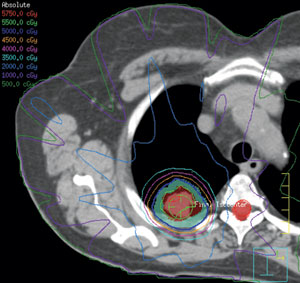 In the first attempt to assess the quality of cancer centers in the U.S., a group of physicians confirmed that cancer centers following the established guidelines for stereotactic body radiation therapy (SBRT) are satisfactorily meeting criteria, thus maximizing the potential success of the therapy for cancer patients. A project of the Community Medical Center initiated in 2006 at the New Jersey CyberKnife, comprised of a group of cancer specialists, the study examined patient data collected through the RSSearch Registry in order to effectively perform the analysis.
In the first attempt to assess the quality of cancer centers in the U.S., a group of physicians confirmed that cancer centers following the established guidelines for stereotactic body radiation therapy (SBRT) are satisfactorily meeting criteria, thus maximizing the potential success of the therapy for cancer patients. A project of the Community Medical Center initiated in 2006 at the New Jersey CyberKnife, comprised of a group of cancer specialists, the study examined patient data collected through the RSSearch Registry in order to effectively perform the analysis.
“The registry was created as a means to follow patients systematically so treatment outcomes and results could be compared appropriately to experiences around the country in academic and nonacademic centers,” says Dr. David D’Ambrosio, medical director of New Jersey CyberKnife and one of several authors of the analysis. “The system collects data and categorizes it in terms of patient toxicity and outcomes in a rigid manner so it can be compared to other centers’ data.”
The analysis included 464 male patients who suffer from prostate cancer and were treated with SBRT between 2006 and 2013 at 33 different U.S. cancer centers. The results revealed a 100 percent biochemical disease-free survival at two years for low-risk patients, as well as 93 percent for intermediate-risk patients and 93 percent for high-risk patients. At three years, the rate raised to 100, 84, and 67 percent, respectively.
Patient outcomes were also concluded to be favorable and the follow-up need at 13 months were relatively short. Despite the overall positive results, Dr. D’Ambrosio called attention to the fact that as the database matures, the analysis will also become more complete and assess toxicity and long-term outcomes.
Stereotactic body radiation therapy (SBRT) is a treatment procedure designed to target tumors outside the central nervous system, in order to treat it with limited but precise, high doses of radiation or a few fractionated radiation treatments.
[adrotate group=”1″]

